Environment Agency – Abu Dhabi (EAD) and Dendra, in partnership with ADQ, are collaborating on a project that aims to support Abu Dhabi’s efforts in coastal eco-systems restoration, specifically mangroves, and comes under the umbrella of the Abu Dhabi Mangrove Initiative (ADMI), supporting Abu Dhabi’s Climate Change Strategy.
The project feeds into local strategic initiatives, such as ADMI, as mangroves are known as nature-based solutions which are important because of their ability to sequester carbon, helping to combat climate change.
The partnership between EAD and Dendra will also provide additional investment in resources and technologies that will help to further increase ongoing mangrove planting efforts in Abu Dhabi.
EAD will provide data-driven guidance through mangrove specialists who have been leading numerous mangrove restoration projects that have integrated technology, local ecology and traditional knowledge. This is alongside EAD’s emirate-wide habitat map, to enhance restoration efforts.
EAD will also be providing support in land selection, methodology and local understanding of the native environment in addition to the findings of the extensive mangrove restoration survey that has preliminary highlighted and ranked areas suitable for plantation and restoration.
Dendra will provide the technology and services via remote-sensing and drone-based seeding in a data-driven approach with the goal of optimising restoration activities and improving outcomes.
Following the assessment and the planting of the area, aerial monitoring and field surveys will be conducted to better understand the rates of germination and determine success. These surveys will be carried out every four weeks for three months, then quarterly for the first year, followed by annual monitoring.
The collaboration will also include additional remote sensing surveys to support EAD’s current knowledge on mangroves, mangrove sites and potential restoration sites and efforts, adding an additional layer of data through the adaptation and use of advanced technologies. This includes the monitoring of 20,000 hectares to obtain red, green and blue (RGB) sensor and multispectral data via drone.
The survey also involves collecting parameters that will allow EAD to identify the health and structure of the population of mangroves. The data will help identify gaps and possible impacts, determine tide levels and water salinity, as well as produce digital elevation models, which are readings of land elevation.
EAD’s science-based approach and guidance, coupled with Dendra’s technologies will support in providing a holistic approach of restoration, and monitoring mangrove ecosystems more effectively.
Ahmed Al Hashmi, Executive Director of Terrestrial and Marine Biodiversity Sector at EAD, said: “We are always looking to establish strong partnerships with government and private sector entities to launch successful projects. Through this collaboration with Dendra, and under the umbrella of the Abu Dhabi Climate Change Strategy, as well as our partnership with ADQ, we will be working on this project to restore coastal ecosystems – mainly mangroves. To ensure the success of the project we are using drone advanced monitoring tools to increase the accuracy of the data regarding the ecosystems before selecting the most ideal areas for restoration. Following this, we will start planting the mangroves under the umbrella of the Abu Dhabi Mangrove Initiative, which will further support the UAE’s Plan to plant 100 million mangroves by 2030.”
The ultra-high-resolution RGB data collected will allow Dendra to identify fauna species and their activities, the impacts of pest and anthropogenics, as well as a full evaluation of the mangrove populations.
The mangrove population is divided into three main categories: conservation, rehabilitation and restoration. The conservation category implies that the mangrove population appears healthy, and a maintenance plan is defined as mangroves are protected. Rehabilitation identifies where the mangrove population has been degraded and would offer a significant and low-risk opportunity for active regeneration. While for restoration, this shows areas where the mangrove population has been largely eradicated and where successful afforestation, which means planting trees in areas not recently covered in forest, is likely to come with greater programme risk.
In February 2022, Abu Dhabi set out ambitious plans to establish the emirate as a global hub for mangrove conservation research and innovation through ADMI. This was announced during His Royal Highness Prince William, the Duke of Cambridge’s, landmark visit to the UAE where he met with His Highness Sheikh Khaled bin Mohamed bin Zayed Al Nahyan, Crown Prince of Abu Dhabi, and Chairman of Abu Dhabi Executive Council, at Jubail Mangrove Park.
This initiative is an extension of the Blue Carbon project, focusing on the importance of mangroves’ carbon sequestration properties to combat climate change. It aims to act as an umbrella for all mangrove research and restoration activities in the emirate and includes the establishment of a state-of-the-art Mangrove Hub (nursery and innovation centre) to ensure science-based implementation of mangrove research and restoration projects in concert with all key stakeholders.
Abu Dhabi has one species of mangrove called grey mangrove (Avicenna marina), locally known as ‘Qurm’, that grows along the shorelines and backwaters of mainland and island coasts. The dense and complex structure of their natural stands provides a rich environment for fish and other species. The current extent of total mangrove cover in Abu Dhabi (as of 2023) is 176 sqkm. Around 20 million mangroves have been planted across Abu Dhabi’s coastal areas since 1987.
Mangrove forests are among the most efficient natural systems at absorbing and storing carbon from the atmosphere. Carbon sequestration rates found in the UAE are relatively higher compared to other reported rates around the Arabian Peninsula. Studies conducted by EAD reveal the ability of mangroves in Abu Dhabi to store carbon at a rate of 0.5 tonnes per hectare annually, which is equivalent to 8,750 tonnes at emirate level, and to the energy consumption of 1,000 homes per year.
As the lead entity in habitat management, protection, and restoration in Abu Dhabi, EAD has been proactively engaged in science-based restoration projects, with extensive experience and a research-driven approach, putting EAD at the forefront of mangrove restoration in the region.
EAD believes in collaboration and engagement with stakeholders, and through ADMI works closely to elevate and support contributions and facilitating a multifaceted involvement in the conservation, and restoration of habitats including mangroves.










